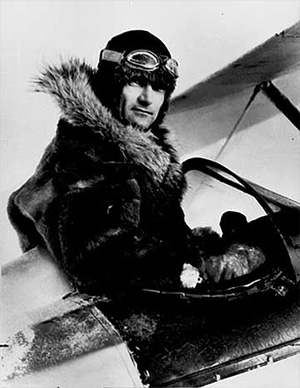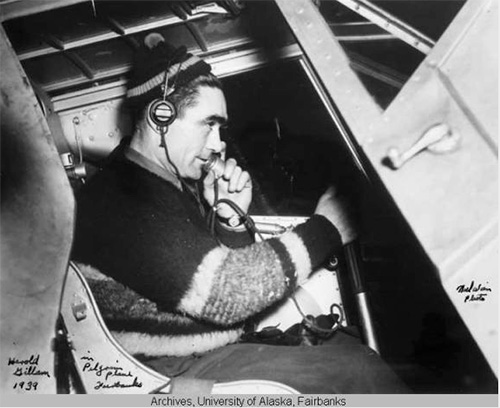
Gillam Crash transfixed KetchikanDramatic rescue of survivors
|
||||
Harold Gillam in the cockpit of his Ski-equipped Waco |
The crash and rescue made national headlines but was particularly followed in Alaska and the Pacific Northwest because of Gillam's reputation as a high flying, risk taking bush pilot from the early days of Alaskan aviation. He was so well known for flying when other pilots wouldn't that other pilots often referred to weather to poor to fly in as "Gillam" weather. News reports of the day noted that Gillam had had more than his share of crashes, but had never had a fatality. He was called, not to his face, as "Thrill em, spill em, no kill em Gillam." That record would change in January of 1943.
Gillam had been flying in Alaska since the late 1920s. He was part of the birth of statewide aviation and although he was still training to be a pilot in 1929, it was he who famously found the wreckage of Carl Ben Eielson's plane in Siberia. He was also engaged, for a time, to Marvel Crosson, one of America's first female aviators, before she perished in a plane crash.
By the 1940s, Gillam had moved into the growing and more lucrative world of corporate air travel. In late 1942, he was working for Morrison-Knudsen, a major contractor that was working at several sites in Alaska, as the territory ramped up its military installations to meet the perceived Japanese threat.
On January 5, 1943, he was scheduled to fly his twin engine Lockheed Electra from Seattle to Anchorage with five passengers. According to later news reports, Gillam found an oil leak in one of the engines and - as was often the case in the rough and tumble world of Alaskan aviation - chose a quick fix, a patch of tape and shellac. The repair delayed the plane's departure, meaning that with the short winter hours the plane would be in darkness when it arrived in Southeast Alaska.
By all accounts, it was a routine winter flight up the inside passage. Fog and overcast skies. Icing expected. Gillam flew on instruments the majority of the flight. One part of the trip was out of the norm. Because it was wartime, coastal flights were expected to maintain radio silence. Wartime procedures also had an effect on the flight. Gillam was planning to stop at the newly constructed military airfield on Annette Island near Metlakatla to refuel. In inclement weather aircraft used an instrument beam to pinpoint the Annette airport, but military protocol called for the beam to be changed sporadically to confuse any enemy aircraft trying to find the airfield. In this case, Gillam did not have the correct coordinates and - rather than flying directly toward the airport on his flight from Seattle - he was approximately 20 miles inland, flying over the coastal mountains near Boca de Quadra.
Just about four hours into the flight, shortly before he was scheduled to land at Annette, Gillam broke radio silence.
"I am in trouble," he radioed. "One engine is out."
Then silence.
When his plane didn't arrive at Annette, searchers began combing the area. After nothing was found in the first two weeks, the search was called off. It was believed that Gillam's plane had likely gone down in the water and would never be found.
But that was not what had happened.
Losing altitude when the engine cut out, Gillam's plane had careened across a mountain top near Badger Lake approximately 15 miles east of the Annette airport and 20 miles south of Ketchikan. All six of the people on board had initially survived the crash, although one - Susan Baxter - a young secretary for the Civilian Aeronautics Administration - had been seriously injured and would die two days after the crash. Gillam himself received a serious head wound. The other people on board were Robert Gebo and Percy Cutting, Morrison-Knudsen employees; Joseph Tippits, an engineer for the Civilian Aviation Administration and Dewey Metzdorf, the owner of the Anchorage Hotel, which was the base for Morrison-Knudsen operations in Alaska. All of the passengers were suffering from broken bones that would limit their mobility.
Charles Harold Gillam in the Pilgrim plane in Fairbanks, 1939. |
Gillam immediately used parts of the downed plane to make shelters for the injured passengers. The original plan was to stay with the downed plane because the plane wreckage itself would always be easier for searchers to spot.
Like most planes flying in Alaska, Gillam's plane had emergency provisions. According to John Tippit's - the son of Joseph Tippet - 2008 book "Hearts of Courage" the crash survivors had two pounds of dried beans, four cans of corned beef, five cans of sardines, 14 bars of chocolate, two pounds of hardtack (pilot bread), eight boxes of bouillon cubes, a pound of coffee and a pound of tea. The survivors estimated that they could survive for a month if they carefully rationed the supplies. They knew that rescuers would be searching for them and they also used matches to start signal fires.
Initially, there was an intense search for the missing plane. The efforts were helped by the fact that because of the war, there was a larger than normal number of military personnel in Ketchikan, Annette and Prince Rupert. In addition to a half dozen Coast Guard vessels, two Canadian Naval vessels took part as well as dozens of planes from the Canadian Air Force which were based at Annette early in the war. Numerous local boats and planes also took part.
Efforts focused on the shorelines, because it was believed that Gillam - experienced with the area - would have tried to put down on one of the area beaches. Because of reports of the a plane being heard circling in the mountains near Prince Rupert, the Skeena River drainage was also searched, as was the entire area of Dixon Entrance between British Columbia and Alaska.
Unfortunately, the weather in the area remained overcast and foggy. While the crash survivors could hear planes passing nearby, they couldn't seem them. They also heard blasting in the distance which they assumed was a rock pit on Annette Island. That sound led the men to think that perhaps they should leave the crash site because they had possibly crashed on Annette Island and could walk to either Metlakatla or the airport. It was January 10 and five days since the crash. Gillam gathered some supplies and headed toward the sound of the blasts.
According to Tippit's book - which was based on information from his father - the survivors remained at the crash site. Then - as the conditions of two of the men, Metzdorf and Gebo, worsened - it was decided that someone else had to make effort to the find help. Cutting headed off in a different direction than Gillam had and reached what was later determined to be Smeaton Bay, but determined it was too isolated and returned to the plane. He did manage to shoot several grouse which provided fresh meat to the survivors.
Meanwhile, the weather was just getting worse at the crash site. More than 10 feet of snow had fallen in the area since the crash and temperatures in that area in January of 1943 were in the teens, 10 degrees below normal. By Friday, January 22, the men decided they needed to get down to sea level if they had any chance of survival. Eventually, they made their way off the mountain top and into a nearby valley that was not as snowbound. They managed to find more grouse and squirrels and began looking for deer. At this point, it was clear that Metzdorf and Gebo had gone as far as they could.
On January 26, Cutting and Tippets pushed on to tidewater. Eventually they reached Weasel Cove, where they found an old, abandoned cabin. They found some weevil infested rice that they ate and a small, barely floating skiff. They also shot and ate several small crows.
They used the boat to get across the bay to the remains of an abandoned cannery, the Pacific American Fisheries cannery, which had operated into the mid 1930s. But there was no food. They decided to use the boat to get down Boca de Quadra to the open ocean. But a storm capsized their boat and they barely made it back to shore.
Finally on February 3, nearly a month after the crash and weeks after searchers had given up any hope of finding the plane or its missing passengers, the Tucsan, a Coast Guard buoy tender captained by A. W. Angellson, found Cutting and Tippets on the shore of Boca de Quadra. Originally, the boat crew thought the men were trappers or miners and were shocked to find out the men were from the missing plane. Other rescuers were alerted and Metzdorf and Gebo were also rescued.
Three days later, on February 6, searchers found Gillam's body along the shore not far from Weasel Cove in Boca de Quadra. He was found wrapped in his parachute. He had torn his red underwear into strips and hung it from nearby branches and he had put his flight boots on two poles near where he was found.
In a later article for the Alaska Sportsman magazine, Cutting suggested that Gillam had probably fallen into the water, taken his clothes off and died of hypothermia. Gillam biographer Arnold Griese wrote in his 2005 book "Bush Pilot" that it was probably a combination of things that led to the pilot's death, including his head injury, exhaustion and hypothermia. He said it was entirely in Gillam's character to put his clothing up where it would visible to searchers.
The fact that survivors were located long after they had been given up for lost caused some soul searching in a Ketchikan community that was well versed in searching for lost and missing ships and boats. There was mention in the Ketchikan Chronicle and the Ketchikan Fishing News about potential meetings to set up a community rescue squad. These efforts took on greater urgency when a Pan Am plane crashed on Annette Island four years later. The creation of the Ketchikan Volunteer Rescue Squad came out the response to both the Gillam and Pan Am tragedies.
Related:
Deadly plane crash led to creation of Ketchikan Volunteer Rescue Squad; 1947 Pan Am crash on Tamgas Mountain killed 18 By DAVE KIFFER
Harold Gillam: A Tragic Final Flight; Ketchikan remembers the search By JUNE ALLEN
SitNews - October 24, 2017
SitNews - August 17, 2004
On the Web:
Columns by Dave Kiffer
Historical Feature Stories by Dave Kiffer
Contact Dave at dave@sitnews.us
Dave Kiffer ©2018
Representations of fact and opinions in comments posted are solely those of the individual posters and do not represent the opinions of Sitnews.
SitNews ©2018
Stories In The News
Ketchikan, Alaska
Articles & photographs that appear in SitNews may be protected by copyright and may not be reprinted without written permission from and payment of any required fees to the proper sources.
E-mail your news & photos to editor@sitnews.us
Photographers choosing to submit photographs for publication to SitNews are in doing so granting their permission for publication and for archiving. SitNews does not sell photographs. All requests for purchasing a photograph will be emailed to the photographer.

